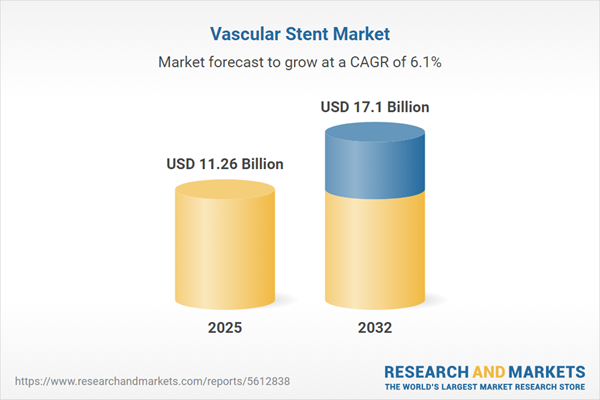Speak directly to the analyst to clarify any post sales queries you may have.
Strategic innovation, regulatory changes, and shifting healthcare demands are redefining the vascular stent market, presenting decision-makers with evolving opportunities and operational imperatives for global growth.
Vascular Stent Market Snapshot
The vascular stent market expanded from USD 10.65 billion in 2024 to USD 11.26 billion in 2025 and is projected to continue growing at a CAGR of 6.09%, reaching USD 17.10 billion by 2032.
Market developments center on technological differentiation, compliance with heightened regulatory requirements, and evolving care delivery models across both developed and emerging regions.Scope & Segmentation of the Vascular Stent Market
- Product Types: Balloon-expandable stents, Self-expanding stents
- Material Types: Metallic stents, Polymeric stents, Biodegradable polymers, Non-biodegradable polymers
- Delivery Systems: Bare metal stents, Covered stents, Drug eluting stents
- Applications: Coronary artery disease, Gastrointestinal disease, Peripheral artery disease, Lower extremities, Upper extremities
- End Users: Ambulatory surgical centers, Cardiac centers, Hospitals
- Regions: Americas (including the United States, Canada, Mexico, Brazil, Argentina, Chile, Colombia, Peru), Europe, Middle East & Africa (spanning the United Kingdom, Germany, France, Russia, Italy, Spain, Netherlands, Sweden, Poland, Switzerland, United Arab Emirates, Saudi Arabia, Qatar, Turkey, Israel, South Africa, Nigeria, Egypt, Kenya), Asia-Pacific (China, India, Japan, Australia, South Korea, Indonesia, Thailand, Malaysia, Singapore, Taiwan)
- Key Companies: Abbott Laboratories, Amaranth Medical, Inc., Artivion Inc., B. Braun SE, Becton, Dickinson and Company, Biotronik SE & Co. KG, Blue Sail Medical Co., Ltd, Boston Scientific Corporation, Cardinal Health, Cook Group Incorporated, Elixir Medical Corporation, Endologix LLC, iVascular, S.L.U, Kaneka Corporation, Kyoto Medical Planning Co., Ltd., Lepu Medical Technology, Lombard Medical Ltd., Medtronic PLC, Meril Life Sciences Pvt. Ltd, Microport Scientific Corporation, Otsuka Medical Devices Co., Ltd., Purple MicroPort Cardiovascular Pvt. Ltd, Sahajanand Medical Technologies Limited, Stryker Corporation, Terumo Corporation, Translumina GmbH, W. L. Gore & Associates, Inc.
The Vascular Stent Market and Transformative Technologies
Market trends are fueled by continued advances in material science, digital health integration, and procedural guidance. Stakeholders are evaluating established metallic devices alongside polymeric and biodegradable innovations that seek to improve patient outcomes and streamline follow-up protocols. Emerging remote monitoring features and extended elution profiles for drug-eluting stents enable precise interventions, while image-guided placement technologies optimize procedural success in challenging anatomies. Regulatory demands for robust post-market data and real-world evidence support the shift toward higher-value solution offerings.
Key Takeaways for Senior Decision-Makers
- Strategic alliances and M&A activity are being prioritized to expand product portfolios and access new clinical domains, particularly gastrointestinal and peripheral applications.
- Increasing regulatory focus is prompting accelerated post-approval studies, rigorous quality validation, and the adoption of advanced digital health tools.
- Value-based reimbursement structures are influencing device adoption and incentivizing long-term efficacy and safety data collection by manufacturers.
- Diversification of supply chains, including regional fabrication and local partnerships, is mitigating operational risk amid changing trade and tariff environments.
- Smart delivery systems equipped with connectivity features are driving post-implant monitoring and enhancing data-driven patient management strategies.
Tariff Impact: United States 2025 Adjustments
The 2025 US tariff changes have led to a revision of global supply chain strategies, with manufacturing footprints expanding to include new regional centers. Companies have adjusted price models, introduced value-based contracts, and innovated polymeric technologies to maintain market access and profitability under revised import conditions. Greater supply chain agility and cost management now underpin competitive advantage in the vascular stent landscape.
Methodology & Data Sources
This report leverages comprehensive secondary research—peer-reviewed journals, regulatory submissions, and clinical guidelines—supplemented by interviews with clinicians, procurement experts, and health economists. Additional insights stem from device registries, reimbursement frameworks, and real-world evidence. Iterative expert reviews validate findings and maintain strategic relevance.
Why This Report Matters
- Enables senior leaders to benchmark innovation investments and identify high-value growth segments in the vascular stent ecosystem.
- Supports operational decision-making through an analysis of regulatory shifts, tariff impacts, and supply chain realignment opportunities.
- Clarifies strategic partnership and technology adoption priorities to strengthen long-term positioning and outcome-based contracting.
Conclusion
Sustained growth in the vascular stent market will be driven by responsive innovation, operational agility, and targeted alliances. Executives equipped with these insights can confidently refine strategies and capture evolving opportunities in this dynamic sector.
Additional Product Information:
- Purchase of this report includes 1 year online access with quarterly updates.
- This report can be updated on request. Please contact our Customer Experience team using the Ask a Question widget on our website.
Table of Contents
3. Executive Summary
4. Market Overview
7. Cumulative Impact of Artificial Intelligence 2025
Companies Mentioned
The companies profiled in this Vascular Stent market report include:- Abbott Laboratories
- Amaranth Medical, Inc.
- Artivion Inc.
- B. Braun SE
- Becton, Dickinson and Company
- Biotronik SE & Co. KG
- Blue Sail Medical Co., Ltd
- Boston Scientific Corporation
- Cardinal Health, Inc.
- Cook Group Incorporated
- Elixir Medical Corporation
- Endologix LLC
- iVascular, S.L.U
- Kaneka Corporation
- Kyoto Medical Planning Co., Ltd.
- Lepu Medical Technology(Beijing)Co.,Ltd.
- Lombard Medical Ltd.
- Medtronic PLC
- Meril Life Sciences Pvt. Ltd
- Microport Scientific Corporation
- Otsuka Medical Devices Co., Ltd.
- Purple MicroPort Cardiovascular Pvt. Ltd
- Sahajanand Medical Technologies Limited
- Stryker Corporation
- Terumo Corporation
- Translumina GmbH
- W. L. Gore & Associates, Inc.
Table Information
| Report Attribute | Details |
|---|---|
| No. of Pages | 188 |
| Published | November 2025 |
| Forecast Period | 2025 - 2032 |
| Estimated Market Value ( USD | $ 11.26 Billion |
| Forecasted Market Value ( USD | $ 17.1 Billion |
| Compound Annual Growth Rate | 6.0% |
| Regions Covered | Global |
| No. of Companies Mentioned | 28 |









